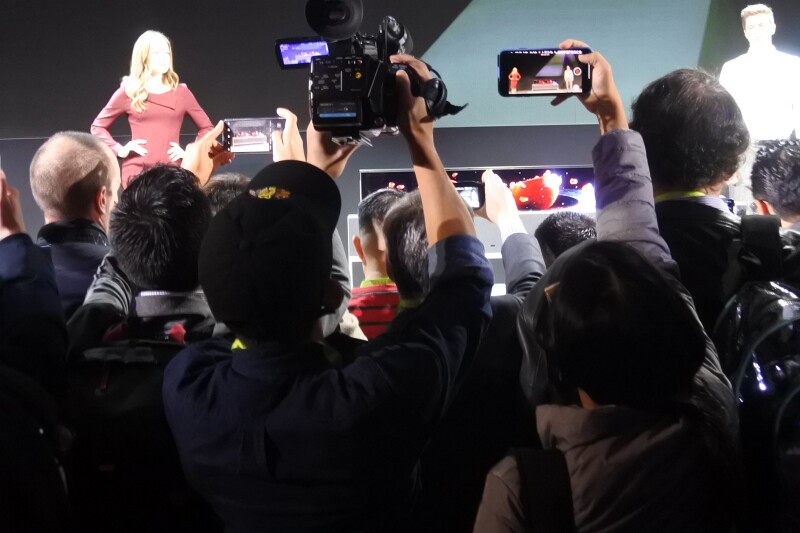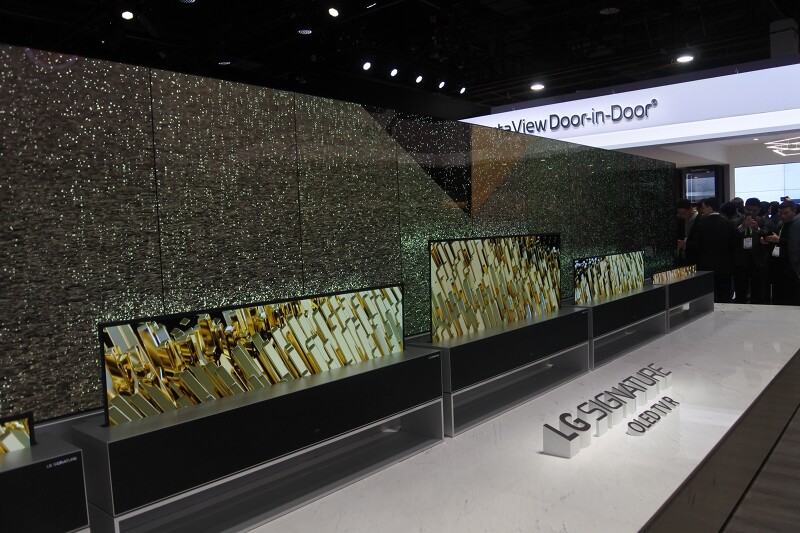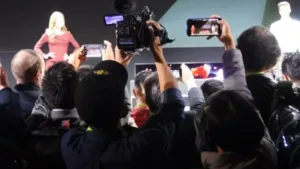For the last couple of years, LG Display has shown a 65-inch rollable OLED-TV screen in its analyst/media/customer suite at CES. This year, LG Electronics introduced the LG Signature OLED TV R rollable television set with high-voltage fanfare (Fig. 1).

The set is a 65-inch, 4K, OLED TV whose screen rises from a slot in its oblong base. The set can operate in different modes with different screen heights protruding from the base.
 1. LG Electronics introduced the LG OLED TV R with all the trimmings, and the tech press responded. (Photo: Ken Werner)
1. LG Electronics introduced the LG OLED TV R with all the trimmings, and the tech press responded. (Photo: Ken Werner)
At LG’s press event held at the Mandalay Bay on the Monday of CES Week, LG showed videos of the OLED TV Rs in multi-million-dollar apartments with window walls and magnificient views — views you would not want to block with a conventional high-end TV screen (Fig. 2). On the evidence of these videos, LGE sees the market for these TVs as the Mar-a-Lago social set. On the show floor, LGE had five of the roll-up sets continually going up and down, and they drew a self-refreshing crowd (Fig. 3).
 2. LGE’s photos and videos suggest the company intend the TV R for people with multi-million-dollar, glass-walled apartments and mid-century Eames chairs. (Photo: LG Electronics)
2. LGE’s photos and videos suggest the company intend the TV R for people with multi-million-dollar, glass-walled apartments and mid-century Eames chairs. (Photo: LG Electronics)
But, although LGE was giving the OLED TV R what looked like a major product roll-out, it’s unlikely the set will be available before the end of the year, if then. Pricing was also not released (although an LG Display representative said to me that it will be expensive – Man. Ed.) An LGD person said LGE intends to wait and see how Samsung responds. I don’t understand that because Samsung does not have a flexible, large-screen technology to respond with.
Samsung dominates the market for flexible RGB OLEDs for smartphones, but they do not have the display technology or manufacturing facillities needed to make TV-sized flexible displays at an acceptable cost. Samsung has announced it is working on QD OLED, which would use blue OLED layer with red and green quantum-dot color convertors. At first look, it doesn’t seem reasonable to base a display technology on the least efficient and shortest-lived of the OLED emitters. But let’s start from a different starting point: LG’s “color by white” OLED technology. LG deposits unpatterned “white OLED,” which is a combination of blue and yellow OLED, which together make “white.” The light passes through an RGB matrix color filter much like the filters commonly used in LCDs.
 3. On the CES show floor, the screens of several TV R’s continually rolled and unrolled to the delight of sizeable crowds. (Photo: Ken Werner)
3. On the CES show floor, the screens of several TV R’s continually rolled and unrolled to the delight of sizeable crowds. (Photo: Ken Werner)
What’s wrong with this? Well, matrix color filters are an expensive component and they also absorb a lot of light, thus reducing efficiency. You might expect that the blue OLED emitter in the mixture might age more quickly than the yellow and cause the white point to shift. However, painstaking testing over thousands of hours by Rtings.com indicate the white point is stable over many thousands of hours except where burn-in has taken place. Still, Samsung’s QD OLED approach would remove the possibility of differential ageing in the components of the OLED mix since there would only be one component. Since the QD OLED approach efficiently converts colors with the quantum dots instead of filtering them, luminous efficiency of the stack should improve significantly.
Samsung has publicized its work on QD OLED, but has been cautious with the details. Blue OLED lifetime and efficiency must be significant challenges, and the QDs will have to be patterned. That has already been demonstrated by a Chinese partner, but not yet in any quantity. However, if the challenges can be met and costs contained, Samsung would have a flexible OLED display that could be used in a rollable TV — if Samsung concludes there is enough of a market to make the effort worth while.
Since we have not yet seen even a technology demo of QD OLED, it is unlikely that Samsung will have a product to challenge LG’s OLED TV R for the next two years. LG does have a habit of worrying about what Samsung will do, but this time the road is clear. – Ken Werner
Ken Werner is Principal of Nutmeg Consultants, specializing in the display industry, manufacturing, technology, and applications, including mobile devices, automotive, and television. He consults for attorneys, investment analysts, and companies re-positioning themselves within the display industry or using displays in their products. He is the 2017 recipient of the Society for Information Display’s Lewis and Beatrice Winner Award. You can reach him at [email protected].

